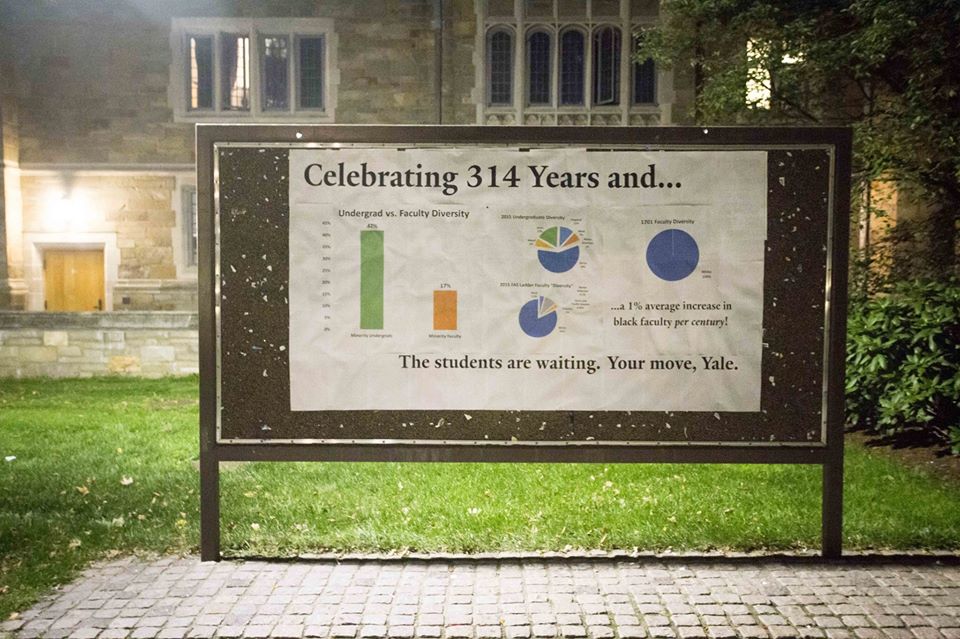by Nicole Chavez
Like most of its Ivy League peers, Yale has never been the front-runner on diversity.
Established in 1701, the college’s founding purpose was to serve as an institution of higher education where the white, wealthy elite would send their sons to be groomed into polished politicians and stoic stockbrokers. Given the great work of Yale’s PR team, one would feel safe to assume that the university has since then made great strides towards cultivating a more diverse community — students, faculty, and staff alike.
Recently, Yale has boasted its efforts in encouraging the matriculation of a more racially and socioeconomically heterogeneous class. However, on Founder’s Day last week, this declaration to the school’s progress on issues of diversity was challenged. A poster was anonymously put up on Cross Campus on Tuesday night — only to be taken down four hours later Wednesday morning — that announced that there is only a “1% average increase in black faculty at Yale per century.”
The bottom of the poster boldly declared: “The students are waiting. Your move Yale.” However, as this poster shows, students are not waiting. They are mobilizing in attempt to tackle the daunting task of diversifying the faculty at this university. The presence of a diverse faculty at any academic institution is beneficial for several reasons. Having diversity mirrored in the faculty provides students from marginalized communities with role models with whom they can relate.
At a privileged institution like Yale, it is especially important that students of color are successful, especially in the classroom. However, at times, students of color do not become aware of the impact the faculty has on them until they experience their elitism first hand.
For Ivonne Gonzalez ’16, her experience “growing up in a low-income neighborhood of color,” conditioned her into perceiving university professors a certain way: “The image that came into my mind when someone said ‘professor’ was a white, older man.” It was not until meeting “Professor Schmidt-Camacho and Master Pitti, who are both phenomenal Latino professors” at Yale that Gonzalez realized how important their presence on campus was, both in supporting the 9% of undergraduates at Yale who identify as Latinx and producing scholarship in the fields of Latinx history and culture.[1]
Besides contributing to the experience of students of color and other marginalized groups on campus, diverse faculty also enhance the college experience of white students by exposing them to different perspectives. In fact, professors who identify as a member of a minority group often are the people most qualified and eager to instruct classes in under supported areas of academia, such as ethnic or queer or gender studies. This gives students a chance to learn about the narratives of marginalized communities from individuals who can speak truly to these experiences.
Reports completed by Yale’s Office of Institutional Research (OIR) point out a lag in the increase of diversity within the faculty at the school. In the 2014 to 2015 school year, racial minorities and females represented 16.1% and 29.0% of individuals on the faculty ladder, respectively. Of the 16.1% of people of color in the faculty, only one Native American faculty member was represented that academic year.
Other racial groups still stood at relatively low numbers, with 20, 24, and 60 Latinxs, African Americans, and Asians and Asian-Americans present on the ladder, respectively. These numbers are diminutive in comparison to the 504 white faculty members at Yale. With nearly 40% of students enrolled at the university identifying as people of color, it is evident that the administration must put forth renewed effort into diversifying its faculty pool.[2]
Along with undergraduates, graduate students are also starting their own initiatives to bring reform to the faculty hiring process at Yale.
On the afternoon of Wednesday, October 7, the graduate English department organized a panel titled Race, Gender, Sexuality, and Belonging in the Academy. The event hosted three professors, Angela Onuwuachi-Willig, visiting professor at Yale Law School; Inderpal Grewal, professor of Women’s, Gender, and Sexuality Studies; and John Dovidio, professor in Psychology. The three convened at this event to share with a group of about 60 graduate students the practices of the university that contribute to the lack of diverse faculty.
Professor Grewal, referencing Cheryl Harris’ text “Whiteness as Property,” described the situation adeptly by drawing a parallel between the struggle for people of color to own property and the fight for marginalized communities to obtain and preserve a space for themselves as faculty in academia. One solution to this issue Grewal suggested was reforming the tenure track which she claimed “reproduced hierarchy in pernicious ways.” These detrimental results are evident in the OIR reports on the headcounts of tenured faculty.
In popular academic departments such as Economics and History where there were 30 and 37 tenured professors in the 2014 to 2015 academic year, women only accounted for 4 and 8 of these people, respectively. Disparities only worsened in STEM-related departments such as Physics, where only 3 of the 25 tenured faculty members are women.[3]
As Onuwuachi-Willig mentioned, the goal of the university should not only be to recruit diverse faculty to Yale, but to make sure they stay here and establish institutional authority as well. This, however, can only be done, as Dovidio stated, by forgoing Yale’s adherence to tradition and desire to keep people happy. Administrators and community members must be willing to have difficult conversations on how to promote diversity and inclusivity.
While the panel on Wednesday focused on the faculty issue, some students suggest that these solutions must extend beyond underrepresentation in academia. Gonzalez, who is also a fellow in the Mellon Mays Undergraduate Fellowship program, which strives to provide undergraduates with resources necessary to enter academia, had the following to say about this aforementioned point:
“Contrary to what some people might think, diversity is not just about increasing the numbers of students and professors of color at Yale. Working towards diversity is also about working towards a better, improved Yale where students can be exposed to a wide array of perspectives. It’s about progressing knowledge production to include the histories and insights of populations who have been erased in dominant Eurocentric scholarship.”
One of the professed goals of Yale as an institution is to mold us into leaders that will initiate positive change in our communities. If this happens to be the case, then why is the school pushing back against students’ attempts to create change now?
***
[1] Office of Institutional Research. “Yale “Factsheet”” Yale University. Web. 10 Oct. 2015. <http://oir.yale.edu/yale-factsheet#YaleCollegeStudentBodyCharacteristics>.
[2] Office of Institutional Research. “Faculty Headcount Summary by Race/Gender” Yale University. Web. 10 Oct. 2015. <http://oir.yale.edu/node/82/attachment>.
[3] Office of Institutional Research. “Tenured and Term Faculty (Headcounts) by Gender (a) 2014-2015” Yale University. Web. 10 Oct. 2015. <http://oir.yale.edu/node/79/attachment>.

